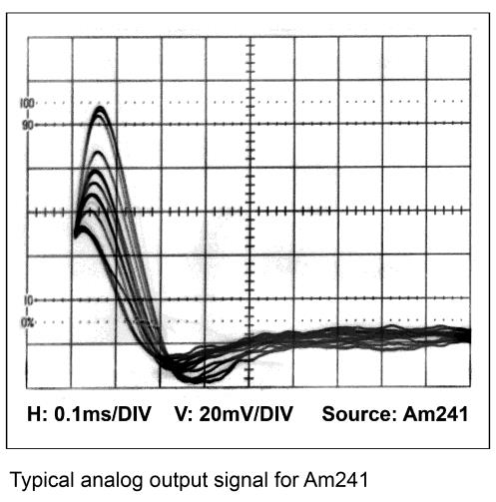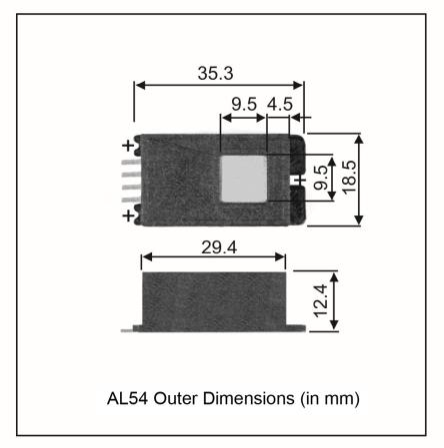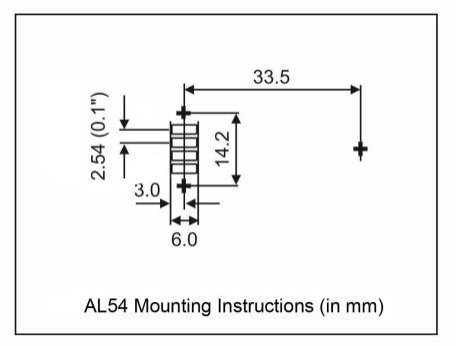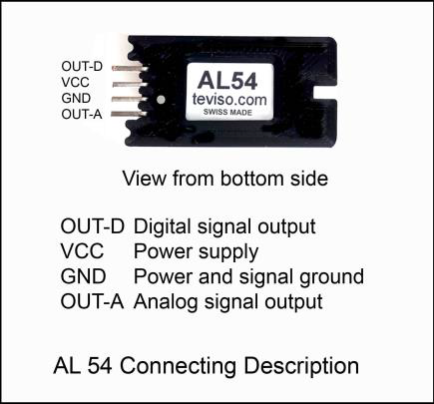Alpha Sensor AL54
- Detects alpha particles, electrons and photons
- Detects decay products of radon
- Works in daylight (no darkroom conditions required)
Features and benefits
The analog signal output of the AL54 makes it the first choice for dedicated researchers and physics students alike.
Fields of application
- Instruments for the detection of radioactivity in the medical environment
- Radiation monitors for nuclear surveillance and safety
- Detection of illegal substances
- Radon experiments
- Scientific courses and practical laboratory experiments
Description of the sensor
The heart of the AL54 radiation sensor is a custom PIN diode covered with a thin aluminum foil to make it insensitive to light. Electrons (beta) and photons (gamma) easily penetrate the aluminum foil. Alpha particles which interact with the aluminum foil generate electrons and photons that can be detected by the PIN diode.
An integrated pulse discriminator with temperature compensated threshold provides a true TTL signal output for alpha particles, electrons and photons. The performance of the AL54 solid-state sensor combined with its extremely low power consumption makes it an excellent choice for physics lab experiments as well as cutting-edge designs.
Absolute maximum ratings
Supply voltage, VCC to GND 18.0 V
Output short-circuit current continuous
Storage temperature range -65 °C to 100 °C
Electrical characteristics
Unless otherwise indicated specified at:
VCC = 5.0 V, TA = 25 °C
Measurement range of dose rate 0.1 μSv/h to 100 mSv/h
Pulse Rate vs. Radiation Rate 5 cpm ± 15% for 1 μSv/h
Energy response 70 keV to 10 MeV
Analog output signal 80mV typical for Am241 Analog output pulse width 100 μs typical for Am241
Digital output pulse level Equal to supply voltage (positive going)
Digital output pulse width 50 μs to 200 μs (LOW→HIGH→LOW)
Supply voltage range 2.5 V to 10.0 V (5.0 V recommended)
Supply current, IS 25 μA TYP
Operating temperature range -30 °C to 60 °C
Sensor characteristics
PIN diode active area 13 mm2
Window Aluminum 9.5 x 9.5 x 0.01 mm

AL54 sensor linearity
dH*(10) / dt = Radiation dose equivalent rate for Cs-137 and Co-60 (mSv/h)

AL54 outline dimensions

AL54 footprint

AL54 connecting description

Detecting alpha particles with the AL54
What happens when alpha particles hit an aluminum foil?
When alpha particles hit an aluminum foil, they can undergo a variety of interactions, including
Elastic scattering: This is the most common type of interaction, where the alpha particle bounces off the aluminum core without losing energy. This is because the alpha particle is so much smaller than the aluminum nucleus that it does not have enough energy to penetrate the nucleus.
Inelastic scattering: This is a more energetic interaction in which the alpha particle gives up some of its energy to the aluminum nucleus. This can happen when the alpha particle transfers some of its energy to an electron in the aluminum atom, causing the electron to be ejected from the atom. The alpha particle can also lose energy by colliding with the nucleus itself.
It is important to know that the extent of these interactions depends on the energy of the alpha particles, the thickness of the aluminum foil and the angle at which the particles hit the foil. These interactions are often used in experiments and detectors to study alpha particles or to shield their radiation in various applications.
